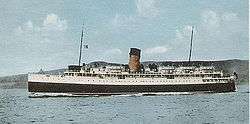SS Princess Helene
 | |
| History | |
|---|---|
| Name: | SS Princess Helene |
| Owner: | Canadian Pacific Railway |
| Builder: | William Deny Co. |
| Launched: | 1930 |
| Renamed: | Helene 1963, Carina 1963, Carina II 1967 |
| Fate: | Sold to Greek owners in 1963 |
| Status: | Scrapped Perama 1977 |
| Notes: | |
| General characteristics | |
| Tonnage: | 4505 Gross Tons |
| Length: | 320 ft. |
| Beam: | 51 ft. |
| Height: | 27 ft. |
| Propulsion: | Steam |
| Speed: | 19 knots |
SS Princess Helene was a historic Canadian passenger and freight ferry operated by the Canadian Pacific Railway (CPR).[1]
Princess Helene was built in 1930 at Dumbarton, Scotland.[2] She was custom designed for CPR’s Bay of Fundy service connecting the CPR's eastern mainline railway terminus at Saint John, New Brunswick with the port of Digby, Nova Scotia, which was served by a CPR subsidiary, the Dominion Atlantic Railway.
Replacing the older and smaller DAR steamer SS Empress, Princess Helene could carry 500 passengers and 50 automobiles as well as large amounts of freight. Special side-loading doors moved vehicles and freight to large wharf elevators at Digby and Saint John to cope with the tidal range in the Bay of Fundy. Princess Helene was part of a chain of CPR's transportation system that “spanned the world” and as such she was outfitted in the style of the company's "Duchess" ocean liners. She had 43 state rooms complemented by beautiful interior fittings that exceeded the usual standards of Canada's regional ferries. Crew uniforms were modeled on the Royal Canadian Navy and each time she passed the DAR's Digby Pines Hotel, bellboys would dip the hotel's flag and salute.[3]
Nicknamed the "Digby Boat", Princess Helene made her crossings without fail across the turbulent and foggy Bay of Fundy and through the dangerous waters of Digby Gut. She steamed 168,400 miles during 33 years of service, including precarious crossings during World War II where she was often escorted by Royal Canadian Navy warships and Royal Canadian Air Force aircraft because of the danger of attack by German U Boats. Princess Helene was replaced April 27, 1963 by the SS Princess of Acadia, formerly the CPR’s British Columbia ferry Princess of Nanaimo. The new ship had greater capacity for automobile and truck traffic but lacked her predecessor's grand ocean liner charm and would be replaced by another newly built vessel carrying the same name MV Princess of Acadia within 7 years.
Hugh "Sam" Macdonald was the longtime Chief Engineer of the SS Princess Helene. His nephew, Donald Stovel Macdonald was a member of Pierre Trudeau's Cabinet and served as President of the Privy Council, Minister of National Defence, Minister of Energy, Mines and Resources and Minister of Finance.
Princess Helene was sold to Chandris Lines of Greece, extensively rebuilt, and renamed Carina II. She operated budget cruises until 1972 when she was laid up and subsequently sold for scrap several years later.[4] A large builder’s model of Princess Helene is preserved today at the Canada Science and Technology Museum in Ottawa.
“The 4,000 ton Princess Helene closed out 33 years service Saturday (May 4th 1963) - on this run patronized by the people of the Maritimes as well as vacationers from other parts of Canada, the United States and elsewhere. While the Helene’s last trip was a nostalgic one for its 240 passengers, it was even more so for Captain A. Roy Conley, master since 1946, who has been with the vessel since she entered service in 1930. Captain Conley has made over 21,000 crossings on the Bay of Fundy during his half-century at sea - 45 of them with the Canadian Pacific. “ The Montreal Gazette - May 6, 1963
See also
Notes
- ↑ Musk, George. (1981). Canadian Pacific: Story of the Famous Shipping Line, p. 261; Ness, Gary. (1988). Canadian Pacific's Dominion Atlantic Railway, Vol. 1, p. 10; Woodworth, Marguerite. (1936). History of the Dominion Atlantic Railway, p. 149.
- ↑ Miramar Ship Index, SS Princess Helene, ID#5411515
- ↑ Donald Scott, "My Interest in the Canadian Pacific", CP Tracks, page 30.
- ↑ Simplon, SS Princess Helene; SS Carina II
References
- Musk, George. (1981). Canadian Pacific: The Story of the Famous Shipping Line. Toronto: Holt, Rinehart and Winston of Canada. ISBN 978-0-03-920291-0; OCLC 7540915
- Ness, Gary. (1988). Canadian Pacific's Dominion Atlantic Railway. Calgary: British Railway Modellers of North America. ISBN 9780919487291; ISBN 9780919487499; OCLC 19848419
- Woodworth, Marguerite. (1936). History of the Dominion Atlantic Railway. Kentville, Nova Scotia: Kentville Pub. Co. OCLC 1549597
External links
- Dominion Atlantic Railway Digital Preservation Institute "SS Princess Helene"
- Admiral Digby Museum Memories Through Time Virtual Exhibit: Transportation